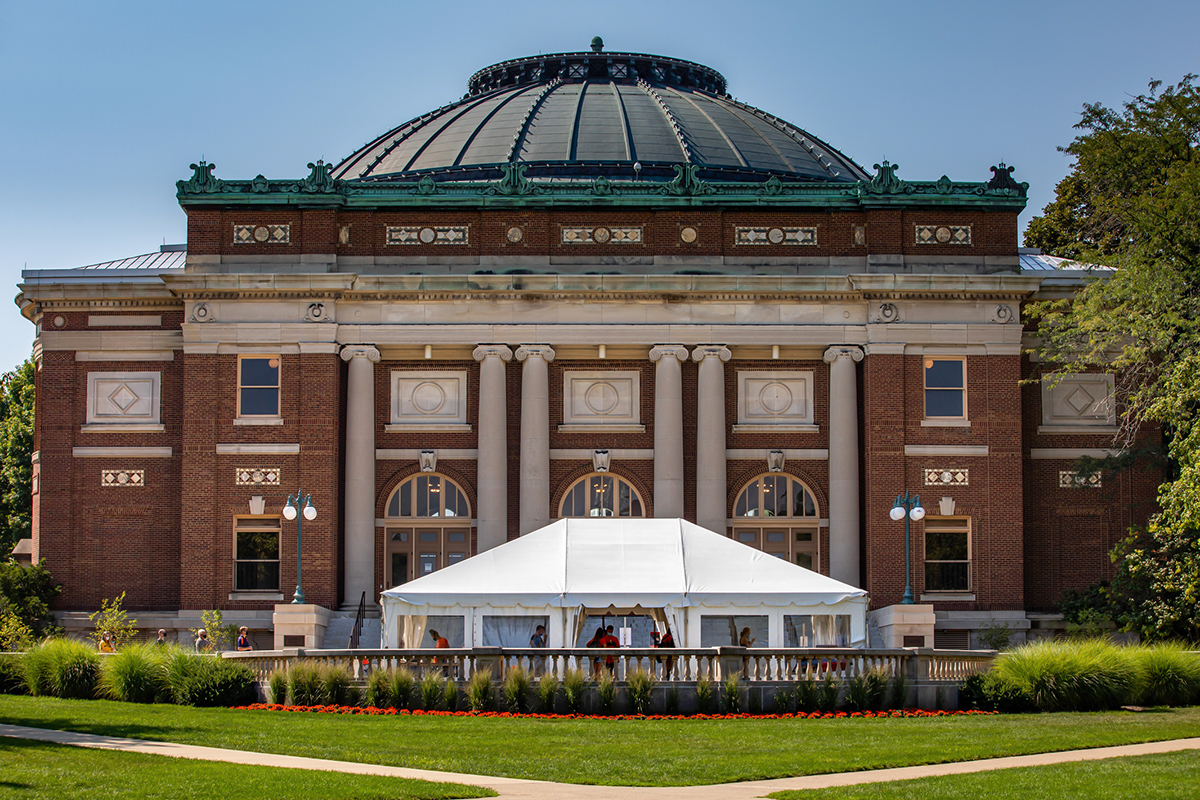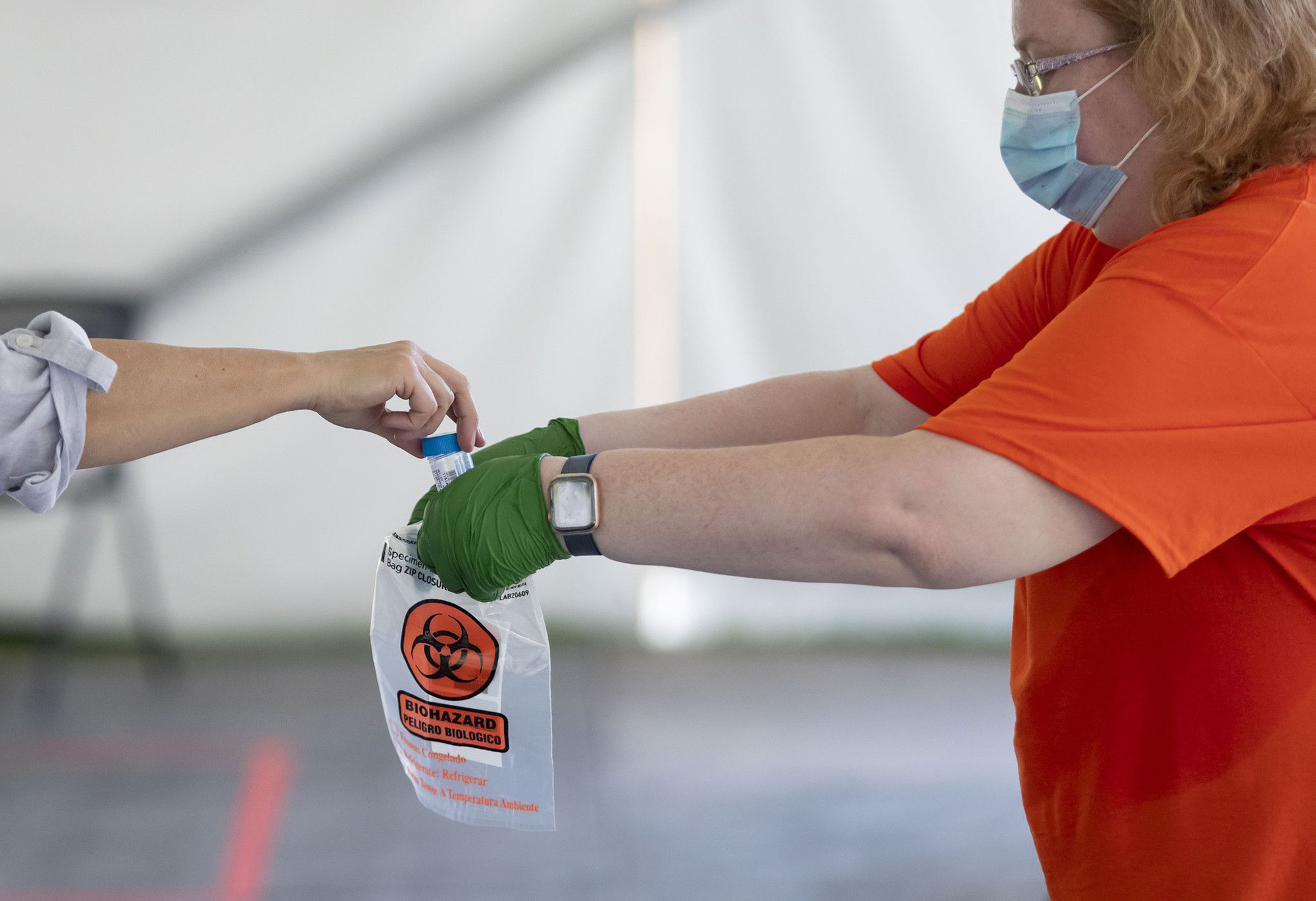Inside University of Illinois' massive COVID-19 testing operation
About 20% of all testing in the state is conducted by the university.
As schools attempt to bring students back to school safely, a game-changer might come out of central Illinois.
The University of Illinois' Urbana-Champaign campus has one of the most aggressive COVID-19 testing protocols among institutions of higher education in the country, as it aims to keep students on campus during the pandemic this fall.
Twice a week, the university tests all students residing on or off campus and employees who report to university facilities using a noninvasive saliva test created by the research institution. That has amounted to as many as 15,000 or 17,000 tests administered in one day -- more tests than most universities with on-campus learning have completed since the start of the pandemic, and what a smaller institution testing all its students might handle in a month.
In the last week of August, the university accounted for nearly 20% of all tests reported in Illinois, according to the state health department. It's even notably measurable nationwide.
"Two percent of all the tests that happen in the country today will be by the University of Illinois," Chris Marsicano, founding director of the College Crisis Initiative at Davidson College -- which is tracking higher education institutions' responses to COVID-19 -- told ABC News.
"Their testing regime is incredible," he added.

Testing is just one part of UIUC's approach to halt the virus in its tracks. Along with measures such as wearing masks, social distancing and contact tracing, it offers a mix of face-to-face, hybrid and online courses to more than 52,000 undergraduate and graduate students.
"The truth is we cannot test our way out of the pandemic," Dr. Rebecca Smith, an epidemiologist at UIUC who designed its testing and exposure notification strategy, told ABC News. "That's never going to be enough."
Test breakthrough
Back in the spring, as UIUC was sending students home at the beginning of the pandemic, university leaders started thinking about how they could get them back on campus safely in the fall.
"We knew there were going to be outbreaks as soon as the students returned," Chancellor Robert Jones told ABC News. "The primary goal was, how do you mitigate those outbreaks?"
Part of that plan was to administer mandatory tests frequently -- upward of 10,000 a day -- and cheaply, with quick turnaround times on results.
"The chancellor and provost said, 'Get it done,'" Dr. Martin Burke, associate dean for research at UIUC's Carle Illinois College of Medicine and leader of the university's testing program, told ABC News. "They wanted to deploy a scalable testing model."
They ruled out the standard nasal swab test, which was cost-prohibitive and impacted by supply chain issues, Burke said. A saliva test seemed the way to go. It showed promise, with greater detection sensitivity than samples from deep nasal swabs, according to an April study by Yale University. It could also be done quickly and wouldn't need to be administered by a health care worker, Burke said.
In mid-May, UIUC began developing its own saliva test with a team that included chemists, data scientists, epidemiologists and veterinary virologists. Burke said the team had a breakthrough in deactivating and isolating the RNA of the virus in a sample -- normally an involved and expensive process -- by heating the saliva sample at 95 degrees Celsius (about 203 degrees Fahrenheit) for 30 minutes.
Most diagnostic testing has had notoriously slow turnaround times. But UIUC's saliva test, which removes some of the steps involved in nasal swab sample testing, can be processed in as little as five hours. Since UIUC performs all its testing in its veterinary lab, versus multiple labs like some colleges and universities do, testing numbers are also easier to track, Melaney Arnold, a spokesperson for the state health department, told ABC News.
All of this innovation comes at a cost. Implementing UIUC's testing capability, including modifying the veterinary lab for COVID testing, ran about $6 million to $7 million, Jones said. It's an investment for the near future.
"We think this has given us a competitive advantage, time will tell," Jones said. "Testing is going to be with us until the next year, next two, maybe next three -- we don't know."
Testing in action
Once the university had a viable test, the team had to determine how often to use it, how to notify people of the results and then have a plan to isolate those who tested positive. "Fast and frequent" is the unofficial motto for the university's testing strategy.
"It really has to be that integrated, fast and frequent testing program to make the whole thing work," Burke said. "Because the pace at which the virus expands inside a person, you really do have a preciously short window of time to find out who's positive, quickly help them isolate safely and stop them from spreading it to others."
Initially, the school thought they'd test once a week, but based on modeling, realized that twice a week would be most effective.
At nearly 20 testing sites set up across campus, students and staff can walk up and self-administer a free COVID-19 test. They are advised to avoid eating, drinking, brushing their teeth, chewing gum or smoking an hour before submitting their sample. Swiping their school ID prints a barcoded sticker that goes on their testing tube. They dribble half a teaspoon of saliva into the tube and put it on a rack with other samples. The whole process takes about seven minutes, Burke said.

Every hour, the racks of samples are delivered by golf cart to the campus' veterinary lab and go straight into the hot water bath to deactivate the virus. The lab runs tests 24 hours a day on weekdays, and nearly that on weekends.
When the lab scans the barcode on the test tube, it connects to the person's medical record. The results of the test are delivered via a HIPAA-compliant secure portal or app, dubbed Safer Illinois, that UIUC created. App users can also opt in to a Bluetooth feature that alerts them if they've spent more than 15 minutes within 6 feet of a confirmed case and should get tested.
If faculty, staff and students receive a negative result at least every four days, they get a checkmark in the app and can enter campus buildings with their school ID. Some bars and restaurants are also using the app to let students gain entry, Burke said.
Another key feature of the school's COVID-19 strategy is isolating those who have tested positive as soon as possible. The university has found that the local health department has had trouble getting ahold of students promptly, with some students purposely ignoring the calls, Burke said, so it recently started directly reaching out to them. Its goal is to contact a positive case within 30 minutes and connect them with support.
Smith said the school has received a positive response from students. "It's nice to know there's a human looking out for them," she said.
JJ Kim, a UIUC junior and editor of the student newspaper, The Daily Illini, told ABC News he was "skeptical" at first how long the school would be able to keep its campus open. But so far, the school's testing efforts and enforcement of masks and social distancing have been mostly encouraging.
"Hearing the way our school has handled coronavirus compared to other schools, I feel relatively safe," Kim said. "Just seeing every school around us go down like flies, it feels like the last man standing kind of thing."
Course correction
The testing works "as long as everybody does their part," Burke said. The team anticipated that wouldn't always be the case, and their data models accounted for issues like noncompliance with mask-wearing and social distancing in determining how often to test the campus. But what they didn't predict, he said, was that some students would not follow orders to isolate after testing positive for COVID-19 or quarantine after they had been in contact with someone who tested positive.
On Sept. 2, the university reported it had seen more than 400 new positive cases since the first day of classes on Aug. 24. It pointed to large parties and gatherings over the past weekend as the main culprit, as well as students ignoring guidance to isolate and quarantine.
The positivity rate had also increased in the days leading up to Sept. 2, from around 0.5% when students first returned to campus to a peak of 2.86%. That day, the school announced it would be going into a two-week lockdown, with only essential activities like food shopping and getting tested permitted, to help curb the recent rise in cases.
In addition to the lockdown, the school is also "intensifying" disciplinary action, it said. UIUC has suspended a handful of students for the fall semester, and is investigating about 100 other infractions, Jones said. "We certainly hope that people learn lessons from this, that we're serious," the chancellor said.
Now, a week after announcing the lockdown, the positivity rate on campus is around 1%. Jones would like to see it get back down to around 0.5%.
"That is very low relative to some of our peers that have had double-digit positivity rates," Jones said. "That is our goal, to never allow it to get as high as some of our colleagues have experienced."
As the testing capacity has increased, the lab has also experienced a bit of a slowdown in turning around results, with some taking up to 48 hours, Smith said. The university has recently introduced robotics, with plans to add more, to help accelerate and streamline the lab work. Smith is also helping to run monthly risk surveys to help narrow down who is most likely to get the virus. "Right now we're fishing in the ocean, and we'd rather fish in a pond," Smith said.
One thing that's become apparent: Most confirmed cases -- around 95% -- are in undergraduates, officials said. This week, the school told faculty they could now get tested once a week if they so choose, Jones said.
"This data is allowing us to look at this in a much more aggressive, comprehensive way than any place that I know of," he said. "We certainly hope that that is going to allow us to keep our community safe and mitigate the spread."

Illinois and beyond
The saliva-based test, which was approved by the Food and Drug Administration under an emergency use authorization last month, is also being used on University of Illinois campuses in Chicago and Springfield.
UIUC has also fielded interest in its test from more than 35 universities. One -- Illinois State University -- is in the process of building out a $1 million lab, with plans to give students, faculty and staff the saliva test at least once per week.
"As our surveillance testing ramps up, we expect that expanded testing will result in a lower positivity rate," John Baur, professor of chemistry and COVID-19 testing coordinator at Illinois State, said in a statement.
UIUC is building mobile labs to perform COVID-19 tests in different communities in Illinois. The first is set to roll out in the coming days, officials said. It is also exploring the possibility of working with different countries and cities, as well as communities like Army bases and prisons, and sharing what it's learned.
"More important than our test is our program -- just trying to think about the whole thing. How do you create a bubble?" Burke said. "I think the lessons that we are learning by running this program will perhaps be more valuable than the test itself."
Dr. Jay Bhatt, a practicing internist and Aspen Health Innovators fellow, is an ABC News contributor.




